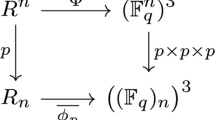Abstract
The affine linear group of degree one, \(\text {AGL}(1,\mathbb {F}_q)\), over the finite field \(\mathbb {F}_q\), acts sharply two-transitively on \(\mathbb {F}_q\). Given \(S<\text {AGL}(1,\mathbb {F}_q)\) and an integer k, \(1\le k\le q\), does there exist a k-element subset \(B\subset \mathbb {F}_q\) whose set-wise stabilizer is S? Our main result is the derivation of two formulas which provide an answer to this question. This result allows us to determine all possible parameters of binary constant weight codes that are constructed from the action of \(\text {AGL}(1,\mathbb {F}_q)\) on \(\mathbb {F}_q\) to meet the Johnson bound. Consequently, for many parameters, we are able to determine the values of the function \(A_2(n,d,w)\), which is the maximum number of codewords in a binary constant weight code of length n, weight w and minimum distance \(\ge d\).
Similar content being viewed by others
References
Agrell E., Vardy A., Zeger K.: Upper bounds for constant-weight codes. IEEE Trans. Inf. Theory 46, 2373–2395 (2000).
Bender E.A., Goldman J.R.: On the applications Möbius inversion in combinatorial analysis. Am. Math. Mon. 82, 789–803 (1975).
Brouwer A.E., Etzion T.: Some new distance-4 constant weight codes. Adv. Math. Commun. 5, 417–424 (2011).
Brouwer A.E., Shearer J.B., Sloane N.J.A., Smith W.D.: A new table of constant weight codes. IEEE Trans. Inf. Theory 36, 1334–1380 (1990).
Cameron P.J., Maimani H.R., Omidi G.R., Tayfeh-Rezaie B.: 3-Designs from \(\text{ PSL }(2, q)\). Discret. Math. 306, 3063–3073 (2006).
Cameron P.J., Omidi G.R., Tayfeh-Rezaie B.: 3-Designs from \(\text{ PGL }(2, q)\). Electron. J. Comb. 13, R50 (2006).
Chee Y.M., Xing C., Yeo S.L.: New constant-weight codes from propagation rules. IEEE Trans. Inf. Theory 56, 1596–1599 (2010).
Hou X.: Optimal binary constant weight codes and affine groups over finite fields. arXiv:1707.02315.
Hou X.: The Möbius function of the affine linear \(\text{ AGL }(1,q)\), preprint.
Huffman W.C., Pless V.: Fundamentals of Error-Correcting Codes. Cambridge University Press, Cambridge, UK (2003).
Johnson S.M.: A new bound for error-correcting codes. IEEE Trans. Inf. Theory 8, 203–207 (1962).
Östergård P.R.J.: Classification of binary constant weight codes. IEEE Trans. Inf. Theory 56, 3779–3785 (2010).
Schrijver A.: New code upper bounds from the Terwilliger algebra and semidefinite programming. IEEE Trans. Inf. Theory 51, 2859–2866 (2005).
Semakov N.V., Zinov’ev V.A.: Balanced codes and tactical configurations. Probl. Inf. Transm. 5, 22–28 (1969).
Smith D.H., Hughes L.A., Perkins S.: A new table of constant weight codes of length greater than 28. Electron. J. Comb. 13 Article 2 (2006).
Sun H.-M.: From planar nearrings to generating blocks. Taiwan. J. Math. 14, 1713–1739 (2010).
Sun H.-M.: Some sequences of optimal constant weight codes. J. Alg. Appl. 17, 1850027 (2018).
Tonchev V.D.: Combinatorial Configurations. Longman-Wiley, New York (1988).
Author information
Authors and Affiliations
Corresponding author
Additional information
Communicated by Q. Xiang.
Publisher's Note
Springer Nature remains neutral with regard to jurisdictional claims in published maps and institutional affiliations.
Appendix
Appendix
1.1 A1. A Mathematica code for computing \({\mathcal {N}}(S(\gamma ^{(q-1)/d},0,H),k)\)
In the following Mathematica program, the input is \(q=p^\alpha \); the output is the array \((k,d,o_d(p),i,j,\beta ,{\mathcal {N}})\), where

1.2 A2. Numerical results
Table 1 gives the values of \({\mathcal {N}}(S(\gamma ^{(q-1)/d},0,H),k)\) for \(q\le 16\). To recall the meanings of and the conditions on the parameters, refer to (A1.1) in Appendix A1.
Rights and permissions
About this article
Cite this article
Hou, XD. Optimal binary constant weight codes and affine linear groups over finite fields. Des. Codes Cryptogr. 87, 1815–1838 (2019). https://doi.org/10.1007/s10623-018-0581-3
Received:
Revised:
Accepted:
Published:
Issue Date:
DOI: https://doi.org/10.1007/s10623-018-0581-3



